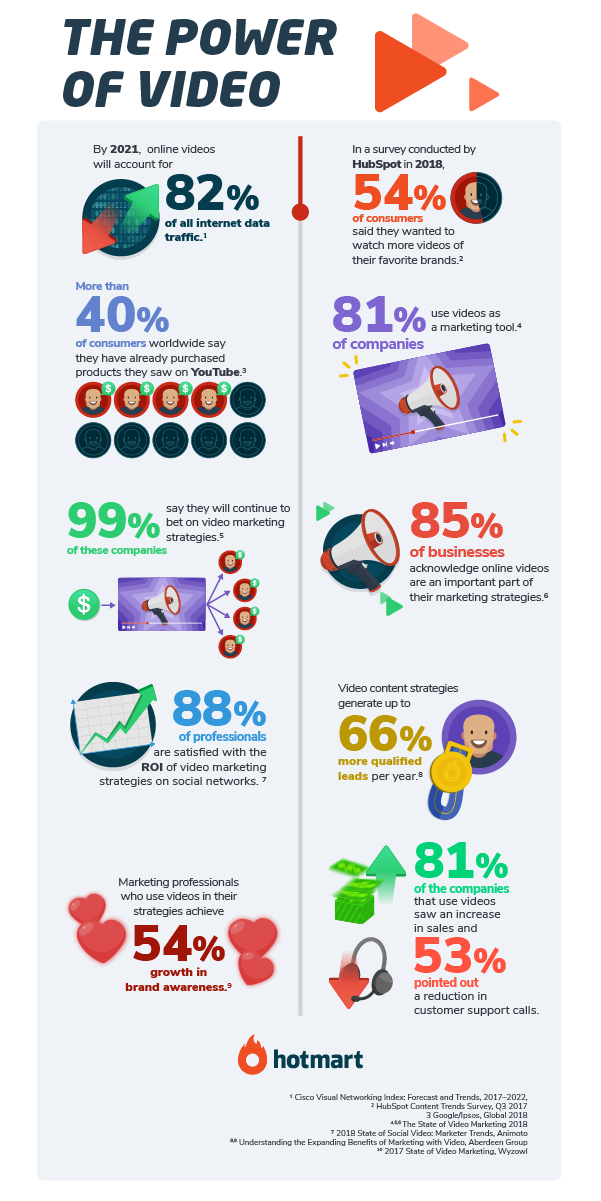
Learn everything about video marketing and how to apply it to your business
Video marketing uses videos to promote products and services and thus, attract and convert customers. Want to know more about this strategy?

You have probably heard that videos are the future of internet content and that you should use video marketing to promote your brand and products. But do you know how to apply this strategy to your business?
Until recently, videos were seen as another component of a broader marketing strategy.
But times have changed. With the digital transformation, this type of content has gained much more relevance and now, videos are the centerpiece of the actions and efforts of many of the major global brands!
This change in attitude isn’t a coincidence. After all, videos are taking over the internet (if they haven’t already!) and have become the type of content consumed the most by people.
Just to give you an idea, Video consumption statistics have shown that, as of 2020, internet video is the main source of information for 66% of people around the world.
Videos are no longer merely entertainment. They work as a source of information and even help many consumers in their purchasing decision. More than half of the consumers state that online videos help them choose a specific brand or product, according to a Google study.
In other words, if you aren’t applying video marketing to your business correctly, you’re missing out on many incredible opportunities (and as a result, money!).
Therefore, we’ve prepared this complete guide with everything you need to know about video marketing. You’ll learn about its benefits and main types, what you need to create a video marketing plan, and how to monitor the results closely.
Check out what you’ll learn in this complete guide:
What is video marketing, anyway?
A video marketing strategy consists in marketing through audiovisual content. In other words, it uses videos, either online or broadcast on TV, to promote a product or brand and thus, attract, convert and build customer loyalty.
But don’t think that video marketing consists only in trying to make sales using videos. This strategy goes far beyond that and includes:
- Video advertising for the internet, or video ads
- Institutional videos to strengthen a brand or institution’s image
- Educational videos, part of the content marketing actions
- New product presentation and demonstration videos
- Success cases and customer testimonials
- Periodic video content, such as personal vlogs
- Live streams and webinars
- Among others.
As you can see, video marketing is a very versatile strategy that can be performed in several channels and formats, as we’ll see in this article.
Understand the power of videos
Before jumping into the topic and learning how to set up your video marketing strategy, it’s important to understand how videos have become a favorite format on the web.
Have you watched any videos today? We’re pretty sure you said “yes”. You and most internet users probably have.
According to The State of Video Marketing 2018 survey, people consume, on average, an hour and a half hours of online videos every day. And 15% of users go further, watching videos over three hours a day.
That’s more than 1 billion hours of videos watched every day on YouTube, according to the largest search engine on the internet, second only to Google.
On social media, the situation is no different. Every day, Facebook accounts for 100 million hours of videos watched. On Instagram, Stories already account for over 500 million viewers. And even on Twitter, videos are a hit, with 82% of its users watching videos on the platform.
And what is it that makes so many people spend their time watching videos?
In addition to seeking entertainment, web users also access online video platforms to learn new things and to stay informed.
Videos are also the preferred channel for web users to interact with their favorite brands. In fact, 79% of users consider videos as the best format to follow a brand online, according to Brightcove data.
With their rising popularity, it was only a matter of time before videos attracted the attention of brands and marketing professionals. An increasing number of companies, whether large, medium or small, are using videos as a channel to relate to their audience and promote their businesses.
In the infographic below, you can check out the statistics that prove that video marketing is here to stay!

So, should you only focus on video marketing?
With so many advantages and an increasing presence online, should videos become your number one strategy? Is it time to abandon your blog and become a YouTuber?
Well, not quite…
As you can see, if you don’t invest in video production, you’ll be missing out on great opportunities for growth and business.
However, this doesn’t mean that other strategies, such as writing blog posts, email marketing and paid media have become obsolete.
The most important thing in marketing is to assess your business needs, the goals you expect to achieve, and above all, the type of content with the best chances of impacting your target audience.
In other words, video marketing will be of no use if you don’t focus and if your audience wants to consume another type of content – even if your videos are very well produced, with amazing images and a great presentation.
Why you should invest in videos
With the statistics we’ve presented, you should already have a good idea of the benefits of investing in video marketing. But they aren’t the only reasons for investing in video production for your business.
Check out 10 more reasons to start investing in video marketing right now:
1. They are easy to produce
One of the biggest doubts beginning entrepreneurs and brands have regarding video marketing is the difficulty to start applying this strategy.
You’re probably wondering that, in order for this strategy to be successful, you need state-of-the-art cameras and microphones, a professional studio and a specialized team.
Well, not necessarily. Contrary to what common sense dictates, nowadays it’s not so hard to produce videos.
Although productions that are more complex require specialized equipment and professionals, simpler content— such as vlogs, demonstration or live videos—, basically require a camera and a computer or smartphone.
The most important thing, as shown in this article, is to produce useful content aligned with your audience’s interests.
2. They easily explain complex concepts
When you want to learn a concept that is more complex or are looking for the steps on how to do something, which do you prefer, a long article or an explanatory video?
If you answered that you prefer a video, there’s a reason for that. In fact, most web users click on video results to learn something quickly.
This is because videos gather visual, chart and audio elements in one place. This makes it much easier to explain complex concepts or show the details of a product in a video than in an article, for example.
In addition to making the understanding of information easier, videos also help you retain it better. People usually remember only 10% of the information they hear. But, audiovisual resources increase content retention, reaching 65% of the information three days after, according to Brain Rules data.
Think about that when you want to promote your business’ launches.
3. They are more responsive
Another reason to start investing in video marketing is the fact that this type of content is very responsive. Users can watch a video on practically any device with internet access, such as TVs, laptops, tablets and smartphones.
This flexibility is very important nowadays, since cell phones have become the most used device for browsing the internet.
This means that those who work with content production need to make sure that their material is compatible with any devices and screen size. After all, if users notice that your content isn’t displayed correctly on the device they’re using, there’s a great chance that they’ll abandon your brand.
And do you know who comes out ahead in this race? That’s right, videos! They can be watched on smartphones, tablets, desktop computers and even on TV.
4. They increase your audience’s engagement
Because they are audience favorites, easier to watch and responsive, it was obvious that videos would be more engaging.
And in fact, they are! Would you like proof? According to Forbes, visitors spend up to 88% more time on websites with videos.
Besides, according to Social Bakers, posts with videos have a greater reach than other formats, such as images and texts.
And the more people reached by your content, the more comments, likes and shares you’ll receive, increasing the number of people interested in your products and services. And all this reflects on your sales!
5. They go viral more easily
Every digital entrepreneur dreams of seeing their brand become the talk of the town and their content going viral on the internet. And video marketing can help in this process.
Stop for a moment and try to remember the last viral content you received from a friend or family. We’re pretty sure that this content was a video, right?
That’s because audiovisual content is more engaging and attractive than texts. Because of this, according to Simply Measured, videos generate 1,200% more shares than all other content put together!
In other words, if you want your brand’s content to go viral, you need to start producing videos.
6. They improve your blog/website’s SEO
You probably already know what SEO (search engine optimization) is and the main ranking factors Google uses to rank pages.
Most SEO techniques consist in optimizing texts and images. However, one aspect that is little discussed, is that videos have a major influence on ranking.
This is because one factor analyzed by most search engines is the engagement the content receives. And as we have explained in earlier items, videos are much more engaging. Besides, for some time now, Google has been highlighting videos among its search results.
And the data doesn’t lie. According to The State of Video Marketing 2017, 76% of companies that invest in video marketing said that it increased their channels’ organic traffic.
And you already know the rest: the better positioned your content is, the more clicks it’ll receive and consequently, the greater its reach, engagement and conversion will be.
7. They generate more authority
As we’ve explained earlier, people usually watch videos to become informed and learn about something. In this sense, when you produce relevant content, you automatically gain authority in your niche.
In addition to easily showing how a product or service works, online videos can also be used to educate the market through video lessons and tutorials, for example.
Additionally, when the material is produced meticulously and with care, the audience feels that the brand knows what it’s doing and that it has superior technical capacity compared to its competitors.
8. They present great ROI
When choosing which marketing strategy to put into practice, many professionals analyze their ROI, i.e., the capacity of this action to generate concrete results, such as leads and sales.
After all, if a strategy requires major investments but isn’t able to bring enough leads to the brand, it might not be worth it.
In this aspect, video marketing comes out ahead of other marketing strategies.
A survey conducted by the Aberdeen Group showed that companies that invest in videos generate 66% more qualified leads per year and present a 54% increase in brand awareness compared to those that don’t invest in this format.
9. They help you sell more
It won’t do any good if video marketing generates more authority and engagement, or attracts more visitors, if it doesn’t increase your sales.
This type of content is more didactic, generates more empathy and engagement, and ends up being used by your audience as an important factor when it’s time to decide on a purchase.
And this makes perfect sense. When choosing a product or service, an explanatory or demonstration video is able to present more information about the product in a way that is easy to understand.
And consumers know this. According to Forrester, three out of five web users watch videos when they are interested in a product or service. In addition, 52% of consumers say that videos of products help in their purchase decision.
What are the types of video marketing?
Now that you’ve checked out all of the benefits and advantages of video marketing for your business, you’re probably dying to start recording, right?
But before you kick off this process, it’s important that you determine the type of content you want to create. After all, each video format has its own characteristics and requires different resources.
With this in mind, we’ve listed the main types of video you can use in your video marketing strategy:
1. Institutional video
Every brand needs to communicate with its audience, conveying its values and goals and presenting itself in a positive way in the market. And one of the most powerful tools in this sense is institutional videos.
This type of content isn’t used to highlight a product or service. On the contrary, the goal of an institutional video is to present the company and its position to the market. This content is created to strengthen branding, generating identification, recognition and authority.
2. Personal marketing video
Not only brands need to create authority and gain recognition on the web. Professionals and entrepreneurs also need to invest in marketing. And videos can help in this task.
It’s perfectly possible to include video production in a personal marketing strategy, using this type of content to highlight your professional characteristics more effectively and interactively.
3. Commercial video
This type of content is easy to identify. It consists of video advertisements, produced to promote a brand’s products or services.
In this format, the goal is to show consumers not only the product itself, but also how it works, its unique features compared to your competitors and qualities.
Basically, the intention is to sell your brand and create a desire in your audience to purchase your product.
4. Educational video
Educational videos are any types of audiovisual content whose main goal is to teach something to your audience, such as a concept or skill.
With the popularization of the internet, these videos have gained more relevance, giving rise to the video class trend. After all, there’s a large number of people interested in acquiring knowledge. And video, as we’ve seen, is one of the best formats to convey information.
In our YouTube channel, we have different educational video content, where we explain concepts of digital marketing, sales and online course creation. Check out one example below:
5. Video cases
Nothing creates more authority and credibility for a brand or product than knowing real customer success stories. These are the so-called testimonials or success cases.
And best of all, this type of content works even better in video format!
After all, in addition to checking how the product or service has helped consumers to solve a problem, your audience is also watching this customer. This provides even more credibility to the material.
One example is the video below, in which we share the inspirational story of Diego Ishida, a Digital Producer at Hotmart:
6. FAQ video
You have certainly heard of FAQs, or frequently asked questions. They are nothing more than a list of questions commonly asked by customers about a product or service.
And just like success stories, FAQs can also be turned into a video!
Thus, it’s possible to take advantage of all audiovisual resources to create didactic and explanatory material, strengthening your relationship with your audience.
7. Product demonstration
Another type of video that cannot be left out of our list is product demonstration videos. They are ideal to be used on a website’s home page or on a landing page.
Demonstration videos show the audience how your solution works and which problems it solves. And best of all, it doesn’t have to be used only for physical products, but also for services, such as software.
One example is the video below, in which we present a tool on the Hotmart platform, the Checkout Builder:
8. Vlog
If you were using the internet between the late 1990s and early 2000s, you probably remember blogs and photo blogs, online diaries where web users shared their daily lives in text or photo format, respectively.
Nowadays, this format has been updated and has given rise to vlogs, which are basically videos that portray someone’s daily life or brand. They’re widely used by digital influencers, which use social media to show fans a little about their daily activities.
9. Animated videos
Animated videos, in either 2D or 3D, are great content formats to explain complex concepts or that require visual resources to be understood.
For example, they can be used to demonstrate advanced features of an online software or service.
One example is the content below, which tells a little about how Hotmart works:
10. Live streaming
Live streaming has become one of the most popular types of video on the internet over the last few years, especially on social media, which started to offer users live streaming features.
And live streams fit perfectly into a marketing strategy with amazing results. Live videos are among the formats with the most engagement, presenting a retention rate up to 8 times higher, according to Livestream.
Your brand can do a live stream to cover an event, show a campaign’s backstage, interview experts, and hold webinars or a Q&A session with the audience.
How to create a video marketing strategy

Video production, especially when it comes to marketing strategy content, requires special attention and a lot of planning. After all, any slipup may negatively impact the image the audience has of the brand and its products.
But this doesn’t mean that it’s an impossible task. To show you that video marketing isn’t rocket science, we’ve listed nine steps you need to follow in order to implement your strategy.
Check them out:
1. Plan your video marketing content
The first thing you need to do before turning on your camera and recording is to think about the purpose of your video.
But why is this important?
Well, any decision you make during the creative process should focus on your goal and the action you expect the audience to take after they watch the content.
For example, if your goal is to promote the launch of an online course, the type of video and the content will be different from institutional material.
Without carefully defining your goal regarding the production of the video, you’re likely to become completely lost, without knowing where to start and wasting precious time and resources.
Therefore, get your team together and brainstorm. Define what your brand expects to achieve regarding the video. It can be about increasing brand awareness, increasing sales at an event or help in the conversion of a landing page.
2. Choose the performance indicators
Now that you’ve defined the video’s goal, it’s important to choose what the criteria will be for the video to be considered successful and consequently, the KPIs, or key performance indicators, which will be monitored.
For example, if you’re going to launch a new product on the market and intend to create a series of demonstration videos, it might be a good idea to monitor the number of conversions after the content is posted.
Determining in advance the indicators that will be analyzed ensures that you don’t waste time monitoring data that won’t be relevant to your strategy and have a more realistic perspective of your business.
3. Know your target audience well
Another fundamental aspect of video production that you cannot forget, is knowing the profile of your audience well, and that you intend to reach with the content.
This is because the content should be produced according to the audience’s likes, interests and behavior. Details such as format, duration, type of video, hosting and promotion platform depend on this profile.
For example, the types of videos that male teenagers and Twitter users watch are quite different from the most popular content among thirtysomething women who access Facebook more.
So as not to make a mistake during this stage, in addition to defining your persona, it’s important that you answer a few simple questions:
- What are the interests of the audience you intend to reach?
- Which channels (social media, platforms, etc.) do they access most frequently?
- What is the average duration of the content being watched?
- At what time do these people go on the internet the most?
Understanding your audience in depth will help you create assertive content.
4. Study the market and your competitors
Unless you have a revolutionary product or service, never seen before on the market, there’s a good chance that you have competitors in your niche. It’s even more likely that these brands are already investing in video marketing.
The next step in your strategy is to study what these competitors are doing and if they are achieving good results.
Monitoring what other companies in your segment are doing makes it easier to create unique content, exploring points that competitors ignore. And thus, responding better to the audience’s pain.
But watch out, monitoring your competitors isn’t the same as plagiarizing what they are doing. On the contrary, the intention here is to identify and explore opportunities. So pay attention to certain details, such as:
- If these brands already create or are thinking about producing video content
- The format and approach of this content
- Which videos from competitors have the most audience and engagement
- Whether there are points and formats that haven’t been explored by these brands.
5. Plan your content according to the sales funnel
Another key aspect when designing a video marketing strategy is to build the entire trajectory that the audience will take, from the first contact with your videos to the purchase decision.
Because this type of content is quite versatile, videos can fit into any stage of the sales funnel; from helping leads who are discovering they have a problem, to people who are looking for information to help them decide between two similar products.
But you need to watch out here. After all, each video format adapts better to a specific stage of the funnel. Keep this in mind when outlining your strategy.
Top do funnel
During the learning and discovery stage, the audience doesn’t know your company and consequently, the services you offer. Here, people are still trying to grasp that they have a problem to be solved.
Therefore, the ideal thing is to produce content that relates better to the persona’s interests instead of trying to sell your products. Prefer videos that explore the key problems faced by the audience. This will help you build a relationship of trust with the brand.
Among the formats you can explore at this time are webinars, interviews, vlogs and video tutorials.
Middle of the funnel
After they recognize the existence of the problem, your audience moves into the middle of the funnel, in the consideration stage. Now they are researching how to solve this need and it’s time to produce targeted content, presenting practical tips and content that is easy to consume.
Among the video formats better suited for the middle of the funnel are tutorials, interviews, and explanatory and demonstration videos.
Bottom of the funnel
Now that the audience already knows how to solve their pain, it’s time to position your brand as the best option. The key in the decision stage is to offer information that puts any doubts to rest regarding your company and turn these leads into opportunities.
In the bottom of the funnel, videos can help explain a product or service, even those that are more complex. In addition, investing in social proof, with testimonials, is also important to help you convince those who are still in doubt whether they are going to purchase your product.
Institutional videos, case studies, animations, product explanatory and demonstration videos are great options for the decision phase.
Bonus: aftersales videos
Those who work with sales know that the relationship with customers doesn’t end after the purchase is made. On the contrary, it’s only getting started, since after making the sale, you need to retain these customers and turn them into your brand’s ambassador.
In this sense, video marketing can help you in the aftersales stage, building customer loyalty. Therefore, invest in personalized content, tailor-made for those who are already your customers.
For example, you can use videos to advertise exclusive conditions and offers, explain advanced features of a product or service, and even present, first hand, a new launch.
Certain formats are great during this stage of the funnel, such as webinars and livestreams in general, success stories, customized videos (standardized content with the name and information of each user) and explanatory videos.
6. Develop your script
Although it’s tempting to turn on the camera and start recording, there’s one detail that cannot be left out: the script.
The video’s script is a document that summarizes all the necessary information and indications for the production of the content. And this includes things like camera movements, set, the position of the actors, their lines, animations, subtitles, soundtrack and even editing effects.
Developing a script allows you to define, beforehand, crucial details such as the duration of the content, the tone of the language and the visual aids that will be used. In addition, it’s also easier to identify and correct any problems that come up during production, avoiding unforeseen events.
7. Time to record!
All set! With all the details above being ready, it’s time to turn on the camera and start shooting!
When it’s crunch time, it’s very important that you have your script at hand, in addition to carefully checking all the equipment you’re going to be using, such as cameras, microphones and lighting equipment.
Don’t worry if you don’t get it right the first time. If you make any mistakes regarding your lines or the take, stop, take a deep breath, and start over. Later, during the editing process, you can make the proper cuts.
Below, we’ve listed a few tips to help you be successful with your video production:
Camera
We know that any content producer dreams of having the best camera on the market, but this isn’t always possible. After all, this equipment is quite expensive and hard to use.
But don’t worry; you don’t necessarily need professional camera models to produce professional content. Compact cameras with basic features will do the trick, as long as you know how to explore their features.
Knowing exactly the type of content you wish to produce makes it easy to choose the most suitable model. And if you still have questions, check out our article with the best cameras for recording videos.
Microphone
There’s no use in having a high-end camera, with perfect images, if your video’s audio is low or noisy. Remember that a lot of the information conveyed in a video is in audio format.
Therefore, avoid recording with your camera’s internal microphone. Its quality is subpar and will be susceptible to interference.
There are several dedicated microphone models, which you can use in your productions, from the cheapest and most basic to professional equipment. We’ve listed a few models in this article on our blog, in addition to providing you with tips on how to pick the best microphone.
Lighting
For a good image, you need more than a high-end camera. You need to make sure that the environment in which you are recording is well lit.
Ideally, you need to have the right lighting equipment, such as reflectors, LED panels and diffusers. But, if your budget doesn’t allow this, prefer to record in well-lit environments, preferably using ambient light.
To help you in this task, we’ve listed a few tips on homemade lighting for videos in a post here on our blog.
Editing
After you turn off the camera, you’ll likely have hours of takes. Now, you need to organize all of your content in a logical manner, cutting out excesses and adding the necessary effects.
It’s during the editing of your video that you’ll add the subtitles, animations, transitions, sound effects and soundtrack, in addition to making cuts and putting your content together in a logical manner.
Ideally, you should recruit a specialized professional for this task, but there are a few intuitive and easy-to-use editing programs, which ensure very good results.
If you’d like to get to know some of the best video editing programs, make sure you check out our full article on the subject.
8. Promote your content in the right places
If people don’t see you, you will be forgotten. If you want your brand to have reach and recognition, it’s very important that you know where and how you’re going to promote your videos. After all, if your content isn’t on the web, it won’t be accessed and therefore, all of your work and effort will have been for nothing.
But don’t think that all you have to do is upload your video to YouTube and wait for the views and engagement to happen automatically. This task requires strategic planning and a lot of attention in order to reach the expected result.
The first step is knowing exactly where your audience is. Do you remember that earlier in this article we said you need to know your persona?
Well, based on this profile, you can know exactly which channels are accessed the most by your target audience and most importantly, the time when they go online.
Next, get to know the characteristics of each channel. For example, LinkedIn is a social network focused on the corporate audience. Therefore, content posted there needs to be more formal and can be a bit longer. Unlike Instagram, which prioritizes posts that focus more on visuals, short and easy to understand.
Use this information to create a posting schedule, logically organizing when and where each video will be posted. Also, determine the frequency of posting and calls that will be used to attract people’s attention.
9. Measure results
The last step is also one of the most important. After you produce and promote your videos, it’s time to monitor if they are performing well. This way, you can tell if your strategy is on the right track or if you need a few adjustments in order to reach the goals you set in the beginning.
But how do you do this? It’s easy. By keeping an eye on a few performance metrics. There are dozens of data you can evaluate, but the most common ones in a video marketing strategy are:
- Retention rate
- Abandonment rate;
- Conversion, and
- Engagement.
We’ll explain each one of them in detail later one, but for now, it’s important that you monitor this data closely. Also, keep an eye on the KPIs you defined earlier in your planning.
If the numbers are below what you expected, identify what went wrong with your strategy and, if possible, change your approach as fast as possible.
What are the video marketing channels?
Now that you’ve understood how to plan and carry out a video marketing strategy, let’s learn a bit more about the main channels where your content can be posted.
Remember that it’s important to know your persona so you can know in which of these platforms to invest.
YouTube
YouTube isn’t an ordinary site. It’s the largest online video platform in the world, and the place where 90% of users said they discovered new products or brands, according to a Video Viewers survey.
This means that, if you want to have reach and relevance, you need to create a channel on YouTube. This is where most users expect to find quality content, which makes the platform a great showcase for your business.
When Instagram was born, it focused on photo sharing. However, over time, the social network grew and opened up to videos as well.
Nowadays, you can share videos on your feed and also in your Stories, in addition to using IGTV, an exclusive tool for posting longer videos.
If your business depends on visual content, such as fashion for example, you need to use Instagram in your video marketing strategy.
As the largest social network in the world, with over 2 billion active users around the world, Facebook is one of the best video marketing channels.
The tool includes several services focused on posting audiovisual content, such as Facebook Watch, a direct YouTube competitor.
Plus, the social network’s algorithm privileges video content on users’ feed, increasing the reach of these posts.
Twitter is famous for allowing posts using up to 280 characters, and has also surrendered to the power of videos. Especially after the platform acquired Periscope and included the live streaming feature on its app.
In addition to native Twitter videos, the live streams also help win over and engage followers. Besides, if your content is well produced and captivating, you have great chances of going viral, gaining millions of shares and likes in a very short time.
If your audience is interested in professional topics, make sure you invest in LinkedIn videos. The largest corporate social network is also a great video marketing platform.
In fact, a LinkedIn video has approximately is 20 times more likely of being shared than a text, for example. In other words, this tool cannot be left out of your strategy.
Blog
Even if you invest in one or all of the aforementioned platforms, it’s important that you also post your videos on your business blog.
You can embed the content in a blog post, complementing the text’s information or creating a page reserved only for them.
Which video marketing metrics should you monitor?
So, you’ve created your first videos, posted the content on the channels your audience uses the most and the first views and comments started to show up. But how do you know if this strategy is working?
The secret, as you probably remember, is in defining the proper KPIs and metrics for your business and for the goals you expect to reach. Only then will you have accurate data, which is essential when correcting possible mistakes and to improve your strategy even further.
There are dozens of metrics you can monitor to know if your videos are performing well. However, we’ve listed the most common ones you need to keep an eye on. Check them out:
a) Retention rate
The first metric concerns the average time people watch your videos before leaving them. In other words, how long it takes before viewers stop watching.
The retention rate will give you an excellent idea of your audience’s relevance and interest in the subject addressed by each video.
If the metric is too low, it’s a sign that you need to change your approach. Either your audience doesn’t find the topic interesting or the video is too long and boring.
b) Abandonment rate
Next, we have the abandonment rate. This indicator lets you know the exact moment when people stop watching your video.
According to the result, you can adopt strategies to decrease abandonment. For example, if your audience stops watching the video too early, this might be a sign that they prefer shorter, more objective content.
c) Conversion rate
If you want to use videos to sell a product or service, you need to keep an eye on the conversion rate! It shows how many users access a product’s landing page, if they signed up to receive your newsletter or downloaded free resources you make available, for example, from your video.
If this rate is high, it’s a sign that your content was well developed and is able to convince your audience to take another step in their shopping journey. Now, if the result is below what was expected, perhaps you should review your content or add a better CTA.
d) Engagement
This indicator gathers all the data regarding a post’s likes, comments and shares on all channels in which it has been shared.
Through engagement, you know which videos your audience finds more attractive and relevant. Use this information to reproduce the strategies that worked best or correct those that aren’t working well.
Start investing in video marketing now
See how video marketing isn’t rocket science?
And since videos are becoming the audience’s favorite format, you need to include this strategy in your business plans.
With technological advances and the popularization of the internet, producing videos has become easier and more accessible. Creating amazing content is possible even for those who don’t have many resources or professional equipment.
The important thing here is to plan all actions carefully, so as to produce videos that are 100% focused on your audience’s interests and of course, monitor the performance indicators closely.
So, don’t waste time, follow the tips in this article and kick off your video marketing strategy!
And if you wish to go even deeper into the world of audiovisual content, check out our complete guide on how to make videos using only your mobile.





